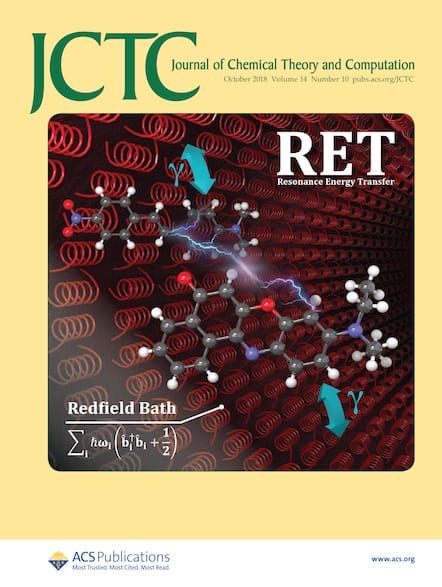Describing Excited States of Covalently Connected Crystals with Cluster and Embedded Cluster Approaches: Challenges and Solutions.
IF 5.7
1区 化学
Q2 CHEMISTRY, PHYSICAL
引用次数: 0
Abstract
Understanding excited-state processes is essential for designing new functional organic materials. Modeling excited states in organic crystals is challenging due to the need to balance localized and delocalized processes and the competition between intramolecular and intermolecular interactions. Cluster models have proven highly effective for describing weakly interacting organic crystals; however, nonperiodic calculations on periodic systems must account for mechanical and electrostatic coupling to the crystal lattice, particularly in cases of extended coordination where covalent bonds are severed, such as in organic polymers and metal-organic frameworks (MOFs). Point charge embedding is a low-cost method for incorporating long-range electrostatics, enabling the consideration of long-range interactions using Ewald embedding. Small clusters have been effective for modeling excited-state processes in MOFs, yet embedding has rarely been included in such studies. In this work, we examine some of the challenges in describing excited states in covalently connected organic crystals using ONIOM(QM:QM') embedding techniques across systems with increasing coordination: diC4-BTBT (an organic molecular crystal), polythiophene (an organic polymer), and two MOFs (QMOF-d29cec2 and MOF-5). We analyze the effects of using different electronic structure methods, including TDHF, TDDFT, ADC(2), and CC(2). One of the main challenges is that embedded cluster models are susceptible to overpolarization near the QM:QM' boundary. To address this, we assess the impact of different charge redistribution schemes (Z-N (N = 0, 3), RC, and RCD) and implement them in fromage. Additionally, we compare cluster and periodic models. We find that localized models effectively reproduce excited states in both nonconnected systems (diC4-BTBT) and fully connected MOFs, whereas polythiophene remains the most challenging due to band conduction. The accuracy of vertical excitations, oscillator strengths, and simulated spectra is strongly influenced by model size, boundary charges, redistribution schemes, and level of theory. We further analyze the effect of vibrational broadening using the nuclear ensemble approach to predict the absorption and emission spectra of MOF-5. Our results provide a heuristic guide for nonperiodic studies of crystalline excited states, highlighting the remarkable relationship between molecular crystals and MOFs, which will be explored in the future work.用团簇和嵌入团簇方法描述共价连接晶体的激发态:挑战和解决方案。
了解激发态过程对于设计新的功能有机材料是必不可少的。由于需要平衡局域和非局域过程以及分子内和分子间相互作用之间的竞争,有机晶体中的激发态建模具有挑战性。簇模型已被证明对描述弱相互作用有机晶体非常有效;然而,周期系统的非周期计算必须考虑到与晶格的机械和静电耦合,特别是在共价键被切断的扩展配位的情况下,如有机聚合物和金属-有机框架(mof)。点电荷嵌入是一种低成本的结合远程静电的方法,可以使用埃瓦尔德嵌入来考虑远程相互作用。小簇可以有效地模拟MOFs中的激发态过程,但嵌入很少被纳入此类研究。在这项工作中,我们研究了使用ONIOM(QM:QM’)嵌入技术描述共价连接有机晶体激发态的一些挑战,这些技术跨系统的配位增加:diC4-BTBT(有机分子晶体),聚噻吩(有机聚合物)和两个mof (QMOF-d29cec2和MOF-5)。我们分析了使用不同的电子结构方法,包括TDHF、TDDFT、ADC(2)和CC(2)的效果。其中一个主要的挑战是嵌入式聚类模型在QM:QM边界附近容易受到过极化的影响。为了解决这个问题,我们评估了不同的电荷再分配方案(Z-N (N = 0,3), RC和RCD)的影响,并在实验中实施它们。此外,我们比较了聚类模型和周期模型。我们发现局域化模型在非连接系统(diC4-BTBT)和完全连接的mof中都能有效地再现激发态,而由于带传导的原因,多噻吩仍然是最具挑战性的。垂直激励、振子强度和模拟光谱的精度受到模型大小、边界电荷、再分配方案和理论水平的强烈影响。我们进一步利用核系综方法分析了振动展宽对MOF-5吸收和发射光谱的影响。我们的研究结果为晶体激发态的非周期性研究提供了启发式指导,突出了分子晶体与mof之间的显着关系,这将在未来的工作中进行探索。
本文章由计算机程序翻译,如有差异,请以英文原文为准。
求助全文
约1分钟内获得全文
求助全文
来源期刊

Journal of Chemical Theory and Computation
化学-物理:原子、分子和化学物理
CiteScore
9.90
自引率
16.40%
发文量
568
审稿时长
1 months
期刊介绍:
The Journal of Chemical Theory and Computation invites new and original contributions with the understanding that, if accepted, they will not be published elsewhere. Papers reporting new theories, methodology, and/or important applications in quantum electronic structure, molecular dynamics, and statistical mechanics are appropriate for submission to this Journal. Specific topics include advances in or applications of ab initio quantum mechanics, density functional theory, design and properties of new materials, surface science, Monte Carlo simulations, solvation models, QM/MM calculations, biomolecular structure prediction, and molecular dynamics in the broadest sense including gas-phase dynamics, ab initio dynamics, biomolecular dynamics, and protein folding. The Journal does not consider papers that are straightforward applications of known methods including DFT and molecular dynamics. The Journal favors submissions that include advances in theory or methodology with applications to compelling problems.
 求助内容:
求助内容: 应助结果提醒方式:
应助结果提醒方式:


